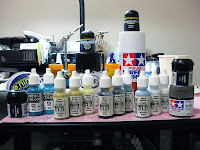 I have finally -- finally! -- gathered all the paints needed for my next project. It took a lot longer than I expected it to, because I had some issues getting a couple of colors right -- mainly, the different shades of turquoise for the base and highlight. Then I needed to find a complementary color range to use for things like cloaks and banners (more on how I did that a little later in this post).
I have finally -- finally! -- gathered all the paints needed for my next project. It took a lot longer than I expected it to, because I had some issues getting a couple of colors right -- mainly, the different shades of turquoise for the base and highlight. Then I needed to find a complementary color range to use for things like cloaks and banners (more on how I did that a little later in this post).Anyway, once the colors were decided and then matched to a real-world equivalent, it became my quest to actually find all the ones I didn't have locally and buy them. I have this thing about buying things locally -- if there's a business in town that carries what I need I'll go there and buy it. Now what with me being a network engineer (well, ok that was my title, before my promotion) that I would be all up in the whole Internet shopping. For most things, you'd be right, but when it comes to hobby-related things, I keep my money in Austin...it's just a thing I do.
Anyway, it took a little time and a little driving about town but I finally got everything I needed and thought I'd share this little portrait of me next project's palette. :)
Now...can any of you guess what my next project is based simply on the colors in the palette? (And no fair telling, fellow Austinites!) I have a feeling some of you just might be able to get it right...
Now let me tell you about a couple of nifty little resources I discovered in my quest to match paint colors to colors in a digital image:
Let's say you have a digital picture or document that has colors you want to match. If you've had artistic training you can probably do it without thinking about it too much. Well...I don't, so...technology to the rescue!
First thing I opened the image in Photoshop CS4. There's a tool in Photoshop that lets you "sample" a color and it will return the "values" of the color in several formats, including RGB "hex" color codes used in web pages. I took a few random samples of the color and then proceeded over to Color Match v1.0. If you've never used this site before...I highly suggest you check it out. You feed it a color -- either one from the extensive list of paint ranges that's available, or by RGB hex value. I fed it the value I'd gotten from Photoshop, unrestricted the paint ranges it would choose from, hit the button and 2 seconds later I"m looking at a graphic of my chosen color surrounded by the six closest matches from it's dat abase (and like I said, it's pretty extensive). After that I used a couple of other sites (that, I just realized, are on my other laptop so I don't have the links for them...let me know if you want them and I'll pop them up later). that will take a color (again, by RGB hex value) and present you with the complementary, contrast, split complement and "box" colors of your color from the color wheel. I think it's pretty bad ass.
Finally, I took the hex values from the color "theme" generating sites and put them back into Color Match and badda bing, badda boom I had the info on the colors I needed.
So there you have it: a portrait of the palette and how I got the paints matched to colors in a digital image.
How about you guys? How do you choose your color schemes? Ever use one of those nifty color wheel thingies? How did things turn out?